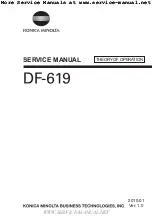
User Manual for PuraLev
®
2000SU
www.levitronix.com
PL-4034-00, Rev02, DCO# 20-144
17
The above curves are measurements of the motor temperature at certain liquid and ambient temperatures.
Equation
shows how to approximately extimate the motor temperature for other liquid and ambient
temperatures based on these curves.
𝑇
𝑀
(
𝑇
𝐿
𝑇
𝐴
) ≈ 𝑇
𝑀
(𝑇
𝐿
= 25°𝐶, 𝑇
𝐴
= 25°𝐶)
⏟
𝐶𝑜𝑛𝑣𝑒𝑐𝑡𝑖𝑜𝑛 𝐶𝑜𝑜𝑙𝑖𝑛𝑔: 𝑠𝑒𝑒 𝐹𝑖𝑔𝑢𝑟𝑒 16
+ (𝑇
𝐿
− 25°𝐶) ∙
𝑡𝑔
𝐿𝑀
⏟
𝑠𝑒𝑒 𝑇𝑎𝑏𝑙𝑒 10
+ (𝑇
𝐴
− 25°𝐶)
𝑇
𝑀
(
𝑇
𝐿
𝑇
𝐴
) ≈ 𝑇
𝑀
(𝑇
𝐿
= 40°𝐶, 𝑇
𝐴
= 25°𝐶)
⏟
𝐶𝑜𝑜𝑙𝑖𝑛𝑔 𝐴𝐶𝑀−4.2: 𝑠𝑒𝑒 𝐹𝑖𝑔𝑢𝑟𝑒 18
𝐶𝑜𝑜𝑙𝑖𝑛𝑔 𝐹𝐶𝑀−2000.1: 𝑠𝑒𝑒 𝐹𝑖𝑔𝑢𝑟𝑒 19
+ (𝑇
𝐿
− 40°𝐶) ∙
𝑡𝑔
𝐿𝑀
⏟
𝑠𝑒𝑒 𝑇𝑎𝑏𝑙𝑒 10
+ (𝑇
𝐴
− 40°𝐶)
𝑇
𝑀
=
𝑀𝑜𝑡𝑜𝑟 𝑡𝑒𝑚𝑝𝑒𝑟𝑎𝑡𝑢𝑟𝑒
𝑇
𝐴
=
𝐴𝑚𝑏𝑖𝑒𝑛𝑡 𝑡𝑒𝑚𝑝𝑒𝑟𝑎𝑡𝑢𝑟𝑒
𝑇
𝐿
=
𝐿𝑖𝑞𝑢𝑖𝑑 𝑡𝑒𝑚𝑝𝑒𝑟𝑎𝑡𝑢𝑟𝑒
𝑡𝑔
𝐿𝑀
=
𝑇𝑒𝑚𝑝𝑒𝑟𝑎𝑡𝑢𝑟𝑒 𝑔𝑟𝑎𝑑𝑖𝑒𝑛𝑡 𝑙𝑖𝑞𝑢𝑖𝑑/𝑚𝑜𝑡𝑜𝑟
(Eq. 1)
Cooling Method
Pump Head Type
Convection
Cooling
Air Cooling Module
ACM-4.2
Fan Cooling
Module FCM-2000.1
DCP-2000 (plastic housing)
0.28
0.29 (at 1 bar)
0.32
Table 10: Temperature gradients liquid/motor
All above presented thermal data are typical values, which are partly based on measurements and partly on
interpolations with a simplified thermal model and are therefore only guideline values and are suitable for a
first layout of the basic thermal concept. It is recommended to check the thermal values with the motor
placed on the final location and under worst case performance conditions of the application.
In order to account for thermal variations (like ambient temperature, closed chemical cabinets or corners
without ventilations) and to not significantly reduce the MTBF of the motor it is recommended to keep about
10 to 20
°C
safety distance to the absolute thermal limit of the motor (90
°C
) when designing the thermal
concept of the pump system.
















































